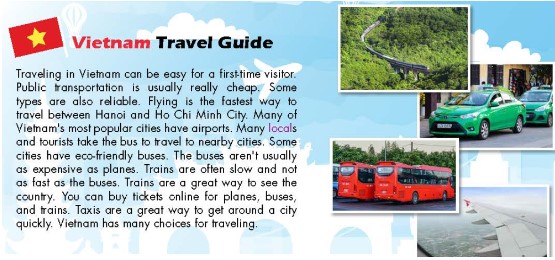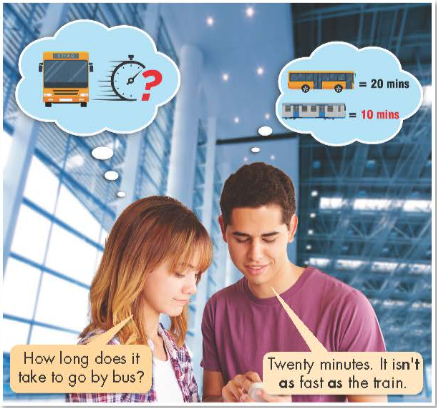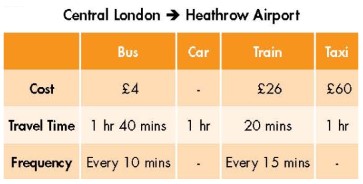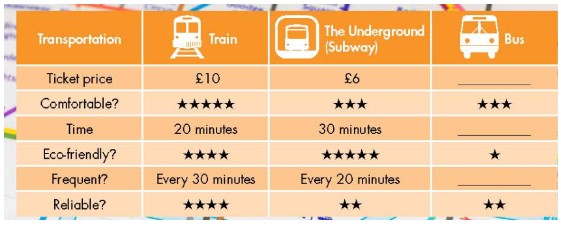Tiếng Anh 7 Unit 7 Lesson 2a. Fill in the blanks. Listen and repeat.b. In pairs: Use adjectives to describe different types of transportation. a. Read the travel guide and choose the best title. b. Now, read and fill in the blanks.c. In pairs: What types of transportation are there in your neighborhood? a. Listen and repeat.b. Rewrite the sentences using (not) as...as...c. Write sentences using the information in the table.d. In pairs: Make more sentences about transportation from the table. Use the prompts.a. Focus on th Lựa chọn câu để xem lời giải nhanh hơn
New Words a a. Fill in the blanks. Listen and repeat. (Điền vào chỗ trống. Nghe và lặp lại.)
Phương pháp giải: - frequent (adj): thường xuyên - eco-friendly (adj): thân thiện với môi trường - comfortable (adj): thoải mái - convenient (adj): tiện lợi - public (adj): công cộng - ticket (n): vé - reliable (adj): có thể tin tưởng Lời giải chi tiết: 1. There are frequent trains from London to Manchester. There are trains leaving every ten minutes. (Có các chuyến tàu thường xuyên từ London đến Manchester. Cứ mười phút lại có những chuyến tàu khởi hành.) 2. It's much more comfortable to travel by car than bike when it's raining. (Đi ô tô thoải mái hơn nhiều so với đi xe đạp khi trời mưa.) 3. Trains are more reliable than buses. They are rarely late. (Tàu hỏa đáng tin cậy hơn xe buýt. Họ hiếm khi đến muộn.) 4. You need to buy a ticket to go on public transportation. (Bạn cần mua vé để đi các phương tiện công cộng.) 5. People can help protect the environment by taking public transportation. It is more eco-friendly than going by car. (Mọi người có thể giúp bảo vệ môi trường bằng cách đi các phương tiện giao thông công cộng. Nó thân thiện với môi trường hơn là đi bằng ô tô.) 6. Buses, trains, and the subway are types of public transportation. (Xe buýt, tàu hỏa và tàu điện ngầm là các loại phương tiện giao thông công cộng.) 7. Taxis are more convenient than buses because they can take you anywhere you want to go. (Taxi thuận tiện hơn xe buýt vì chúng có thể đưa bạn đến bất cứ đâu bạn muốn.) New Words b b. In pairs: Use adjectives to describe different types of transportation. (Theo cặp: Sử dụng tính tử để mô tả các phương tiện khác nhau. ) Buses are cheap and eco-friendly. (Xe buýt rẻ và thân thiện với môi trường.) Planes are fast and expensive. (Máy bay nhanh và đắt.) Lời giải chi tiết: - Taxis are fast and convenient. (Xe taxi nhanh và tiện.) - Bikes are eco-friendly. (Xe đạp thân thiện với môi trường.) Reading a a. Read the travel guide and choose the best title. (Đọc về đoạn hướng dẫn du lịch và chọn chủ đề phù hợp nhất.) 1. The fastest way to Travel in Vietnam (Cách nhanh nhất để du lịch Việt Nam) 2. Traveling in Vietnam (Du lịch ở Việt Nam)
Phương pháp giải: Tạm dịch: Hướng dẫn du lịch Việt Nam Du lịch Việt Nam có thể rất dễ dàng đối với du khách lần đầu đến thăm. Phương tiện giao thông thường rất rẻ. Có nhiều loại phương tiện rất đáng tin cậy. Bay là cách nhanh nhất để đi du lịch giữa Hà Nội và Thành phố Hồ Chí Minh. Nhiều thành phố nổi tiếng ở Việt Nam đều có sân bay. Nhiều địa phương và du khách đi xe buýt để du lịch gần thành phố. Nhiều thành phố có xe buýt thân thiện với môi trường. Xe buýt không đắt như máy bay. Tàu hỏa thường chậm và không nhanh như xe buýt. Tàu hỏa cũng là một cách tuyệt vời khi muốn ngắm nhìn đất nước. Bạn có thể mua vé máy bay, xe buýt và tàu qua mạng. Xe taxi là cách tuyệt vời khi muốn đi quanh thành phố. Việt Nam có rất nhiều sự lựa chọn cho du lịch. Lời giải chi tiết: Chọn chủ đề 2. Traveling in Vietnam (Du lịch ở Việt Nam) Giải thích: Đoạn văn không chỉ nói về cách nhanh nhất để du lịch ở Việt Nam mà còn nói về lợi ích của nhiều phương tiện khác nhau khi du lịch Việt Nam. Reading b b. Now, read and fill in the blanks. (Bây giờ, đọc và điền vào chỗ trống.) 1. The _________way to travel from Ho Chi Minh City to Hanoi is flying. 2. Some cities have_________ buses. 3. The trains are often not as__________ as the buses. 4. You can buy tickets for planes, buses, and trains_________. 5. Taxis are a great way to get around a city_________. Lời giải chi tiết: 1. The fastest way to travel from Ho Chi Minh City to Hanoi is flying. (Cách nhanh nhất để đi từ Thành phố Hồ Chí Minh đến Hà Nội là bay.) 2. Some cities have eco-friendly buses. (Một số thành phố có xe buýt thân thiện với môi trường.) 3. The trains are often not as fast as the buses. (Các chuyến tàu thường không nhanh bằng xe buýt.) 4. You can buy tickets for planes, buses, and trains online. (Bạn có thể mua vé máy bay, xe buýt và xe lửa trực tuyến.) 5. Taxis are a great way to get around a city quickly. (Taxi là một cách tuyệt vời để đi vòng quanh thành phố một cách nhanh chóng.) Reading c c. In pairs: What types of transportation are there in your neighborhood? (Những loại phương tiện nào có trong khu phố của bạn?) Lời giải chi tiết: In my neighborhood, there are some transportations: cars, buses, bikes, motorbikes,... (Trong khu phố tôi có nhiều phương tiện giao thông: ô tô, xe buýt, xe đạp, xe máy,...) Grammar a a. Listen and repeat. (Nghe và lặp lại.)
Girl: How long does it take to go by bus? (Đi xe buýt mất bao lâu?) Boy: Twenty minutes. It isn't as fast as the train. (20 phút. Nó không nhanh bằng tàu hỏa.) Grammar b b. Rewrite the sentences using (not) as...as... (Viết lại câu sử dụng cấu trúc (not) as...as...) 1. My backpack is newer than yours. (old) (Ba lô của tôi mới hơn của bạn.) -> My backpack isn't as old as yours. (Ba lô của tôi không cũ như của bạn.) 2. My suitcase is the same size as yours. (big) (Va-li của tôi cùng cỡ với cái của bạn.) 3. Your sunglasses are more expensive than mine. (expensive) (Kính râm của bạn đắt hơn của tôi.) 4. Trains and buses are both comfortable. (comfortable) (Tàu và xe buýt đều thoải mái.) 5. My ticket is more expensive than your ticket. (cheap) (Vé của tôi đắt hơn vé của bạn.) Lời giải chi tiết: 2. My suitcase is as big as yours. (Va-li của tôi to bằng cái của bạn.) 3. Your sunglasses are as expensive as mine. (Kính râm của tôi đắt bằng cái của bạn.) 4. Trains are as comfortable as buses. (Tàu hỏa thoải mái như xe buýt.) 5. My ticket isn’t as cheap as your ticket. (Vé của tôi không rẻ như vé của bạn.) Grammar c c. Write sentences using the information in the table. (Viết câu sử dụng thông tin trong bảng.)
1. the bus – the train (travel time) The bus isn't as quick/fast as the train. (Xe buýt không nhanh bằng tàu hỏa.) 2. trains - buses (frequency) _______________________________. 3. taxis - buses (cost) _______________________________. 4. the bus - the train (cost) _______________________________. 5. the car - a taxi (travel time) _____________________________. Lời giải chi tiết: 2. Trains aren’t as frequentcy as buses. (Tàu hỏa thì không thường xuyên như xe buýt.) 3. Taxis are more expensive than buses. (Taxi đắt hơn xe buýt.) 4. The bus is cheaper than the train. (Xe buýt rẻ hơn tàu hỏa.) 5. The car is as fast as a taxi. (Ô tô nhanh như taxi.) Grammar d d. In pairs: Make more sentences about transportation from the table. Use the prompts. (Theo cặp: Viết câu về phương tiện từ bảng sử dụng gợi ý.)
Lời giải chi tiết: The bus isn’t as fast as the car. (Xe buýt không nhanh bằng ô tô.) The train is cheaper than a taxi. (Tàu hỏa rẻ hơn taxi.) Pronunciation a a. Focus on the /st/ sound. (Chú ý cách phát âm /st/.) Pronunciation b b. Listen to the words and focus on the underlined letters. (Nghe từ và chú ý những chữ được gạch chân.)
first (đầu tiên) tourist (du khách) festival (lễ hội) Pronunciation c c. Listen to the /st/ sound. Find and note down three more words with the same sound. (Nghe cách phát âm /st/. Tìm và ghi chú hơn 3 từ với âm tương tự.)
faster (nhanh hơn) station (ga) best (tốt nhất) Lời giải chi tiết: story (câu chuyện) stable (ổn định) must (phải) Pronunciation d d. Read the words in "c." with the sound noted in "a." to a partner. (Đọc lại những từ ở phần c với phát âm được ghi chú ở phần a cùng bạn đồng hành.) Practice a a. Practice the conversation. Swap roles and repeat. (Thực hành bài hội thoại. Hoán đổi vai trò và lặp lại.) Bill: We can take the train or the subway. (Chúng ta có thể đi tàu hỏa hoặc tàu điện ngầm.) Lucy: How much is the subway? (Giá tàu điện ngầm là bao nhiêu?) Bill: It's nine dollars. How much is the train? (9 USD. Vậy giá tàu hỏa là bao nhiêu?) Lucy: It's sixteen dollars. The subway isn't as expensive as the train. (16 USD. Tàu điện ngầm không đắt bằng tàu hỏa.) Bill: Yes, but the train has bigger chairs. It's more comfortable than the subway. (Đúng vậy, nhưng tàu hỏa có ghế to hơn. Nó thoải mái hơn tàu điện ngầm.) Lucy: Let's take the train. (Vậy đi tàu hỏa nhé.) Bill: OK
Practice b b. Practice with your own ideas. (Luyện tập với ý tưởng của bạn.) Lời giải chi tiết: My: We can take the train or the plane. (Chúng ta có thể đi tàu hỏa hoặc máy bay.) Lam: How much is the plane? (Giá vé máy bay là bao nhiêu?) My: It's fifty dollars. How much is the train? (50 USD. Vậy giá tàu hỏa là bao nhiêu?) Lam: It's sixteen dollars. The train isn't as expensive as the plane. (16 USD. Tàu hỏa không đắt như máy bay.) My: Yes, but the plane is faster. It's more comfortable than the train. (Đúng vậy, nhưng máy bay nhanh hơn. Nó thoải mái hơn tàu hỏa.) Lam: Let's take the plane. (Vậy đi máy bay nhé.) My: OK. (Đồng ý.) Speaking a a. You are deciding how to get to Richmond Park. In pairs: Student B, 121 File 8. Student A, ask your partner about the bus and answer their questions about the train. Then, compare the different ways to travel and decide how you will get to the park. (Bạn đang quyết định đi đến công viên Richmond như thế nào. Theo cặp: Học sinh B, file 8 trang 121. Học sinh A, hỏi bạn đồng hành về xe buýt và trả lời câu hỏi về tàu hỏa. Sau đó, so sánh các cách khác nhau để đi du lịch và quyết định bạn sẽ đến công viên như thế nào.)
A: How much is the bus? (Giá xe buýt là bao nhiêu?) B: The train is faster than the underground. (Tàu hỏa thì nhanh hơn tàu ngầm.) A: Yes, but the underground isn't as expensive as the train. (Đúng, nhưng tàu ngầm không đắt như tàu hỏa.) Lời giải chi tiết: A: How much is the bus? (Giá xe buýt là bao nhiêu?) B: It’s £10.How much is the train? (10 bảng Anh. Giá tàu hỏa là bao nhiêu?) A: It’s £10. How long does it take by bus? (10 bảng Anh. Đi xe buýt mất bao lâu?) B: It takes 45 minutes.How long does it take by train? (45 phút. Đi tàu hỏa mất bao lâu?) A: It takes 20 minutes. The train is faster than the bus. How often does the bus take? (20 phút. Tàu hỏa thì nhanh hơn xe buýt. Tần suất mỗi chuyến xe buýt là bao lâu?) B: It’s every 5 minutes. How often does the train take? (5 phút một chuyến. Tần suất mỗi chuyến tàu hỏa là bao lâu?) A: It’s every 30 minutes. (30 phút một chuyến.) Speaking b b. Join another pair. Will they use the same type of transportation? Why (not)? (Tham gia vào một cặp khác. Họ sẽ sử dụng phương tiện giống nhau không? Tại sao (không)?) Lời giải chi tiết: They will use the same type of transportation. (Họ sẽ chọn phương tiện giống nhau.)
|


















